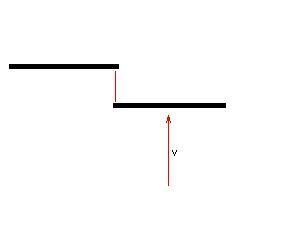okie.............the left rod will rotate in counterclockwise dirn along a axis thru its perpandicular bisector and the right rod will rotate in counterclockwise sense but bout the axis thru its left end and both will have same value of w

Two rods collide with each other as shown above .. What is the motion of the two after collision..
Lenghts are equal and mass is the same (identical rods)
Assume mass m and length L
take coefficient of elasticity as e.
I havent Solved it yet. Nor do I have the answer right now.. I just made up this question 2 minutes back... So if anything u think is missing do ask me.. Even though to me it seems unlikely that u will need something!
-
UP 0 DOWN 0 0 7

7 Answers
Issues:
1) Can we assume omegas(about the CM) after collision to be equal?
2) Which point do we conserve angular momentum?
3) If we cant give "yes" as an answer to 1.. then we will need more information/ Data.
Now, consider the CM of any rod.
rXI(ang impulse) =same.
rXI=ΔL
rXI=Iw1-Iw0
where w1=final angular vel
and w0=initial ang vel
now for both rods w0=0 . Thus the final ang. velocities should be the same.
i cudnt come online since 11:00!!
well here's my solution
let the rods be in contact for a short time interval dt
and let the force acting on both the rods(BY newtons third law) be F
then from the figure
we can see that amgular impulse imparted = FdtL/2 = ML2/12w1
again FdtL/2 = ML2/12w2
so w1 =w2
further due to Fdt
for rod 1
Fdt = mv2 (v2 final velocity for rod in rest intitially)
for rod2
Fdt = m(v-v1) (v1 final velocity of rod 2)
and further it is given that coefficient of restitution = e
now here the problem arises, e can be equated to (rel. velocity after collision/rel. velocity before collision of the bodies)
but , does the term bodies mean the centre of mass or the point of impact?
most probably it is the point of impact as it takes most actively part int the collision
due to e it gets deformed thus in my view bodies = > point of impact
here , rel. velocity of point of impact before collision =
v
after collision =>
v1+wL/2 + wL/2-v2
so ev= v1-v2+wL/2
and further
mv=mv1+mv2 => v=v1+v2
we get =
v1=(v+ev-wL)/2
but we know
Fdt=m(v-v1)
and FdtL/2 = M(L2/12)w
so we get the value of w and v1 and v2
subsequently
Firstly........ both will have same ω as.........
The situation has an element of symmetry....
It will not make a difference whether this rod is coming or other one...
What I basically wanted to know is at which points can angular momentum be conserved.
a) Can it be conserved at the point of collision?
b) Center of Mass
c) Another fixed point!
The basic thing here I think is that It can be conserved about the center of mass. The equality comes from there!